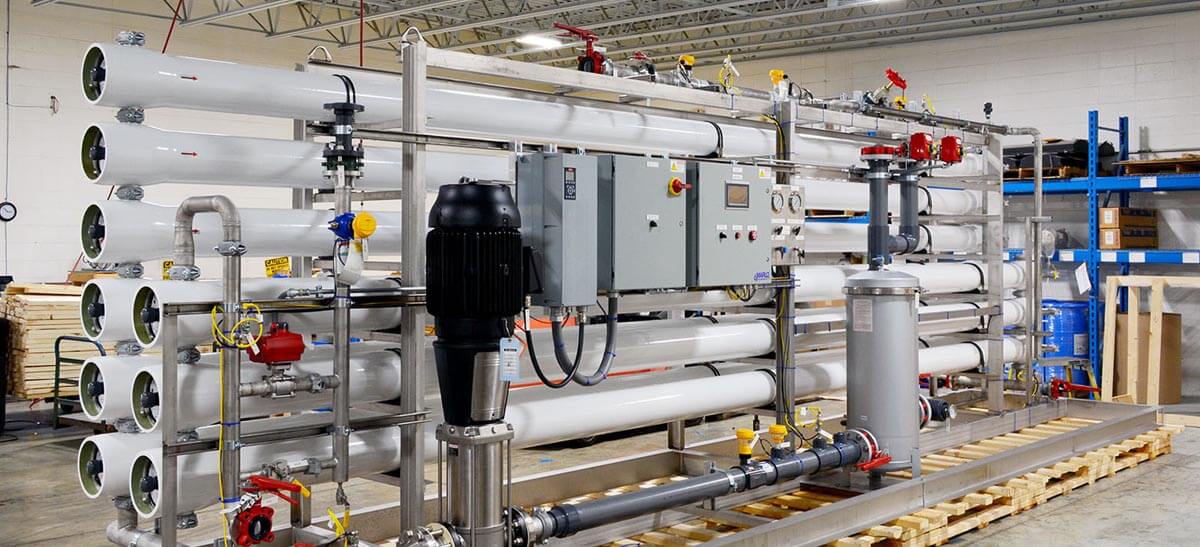Projects Execution Division
Sludge Handling
Filter Press

Filter press with electro mechanical plate shifting device, it is mechanised Recessed plates type filter press of sizes varies from 355 mm x 1200 mm x 1200 mm for 7 bar filtration pressure with and without hydraulic closing devices.
Double acting Hydraulic Cylinder with pressure compensated motorized power pack
The system consists of pressure compensated motorized power pack having high pressure radial triplex plunger pump, solenoid operated direction control valve, pilot operated non-return valve, differential pressure switch, relief valve, pressure gauge and double acting hydraulic cylinder having 800 mm, stroke which closes and seals the filter plates pack automatically and returns the moving head to its open position by simply pressing a button.
Filter press with capstan closing device
This type of closing mechanism is recommended upto 355 mm x 355 mm size press. A screw with hand-wheel is used for closing the pack of filter plates and for final tightening.
Filter press with Ratchet closing device
The system consists of Ratchet lever to the pinion shaft the force is transmitted by small pinion to the larger gear-wheel which provides the final lightning on the plate pack. The system consists of Ratchet Mechanism, Pinion and gear wheel. By applying a Ratchet lever to the pinion shaft the force is transmitted by small pinion to the larger gear-wheel which provides the final lightning on the plate pack.
Advantages
- No need of sludge drying bed
- Dewatering solution to most process flows
- Future expandability
- Reduced labour
- Long service life
- Convenience and reliability
Application
- Chemical Industries,
- Drug Industries,
- Pharma Industries,
- Refineries,
- Leachates,
- Textile Industries,
- Tanneries,
- Rubber,
- Automobile Industries
- Food & Beverages
- Mixed Salt Recovery
- Pharmaceuticals & Bulk Drugs
- Fish Mill
- Sugar Mills
- Electroplating Industries
Decanter

A component with a higher density would fall to the bottom of a mixture, while the less dense component would be suspended above it. A decanter centrifuge increases the rate of settling through the use of continuous rotation, producing a g-force equivalent to between 1000 and 4000 G’s. This reduces the settling time of the components by a large magnitude, whereby mixtures previously having to take hours to settle can be settled in a matter of seconds using a decanter centrifuge. This form of separation enables more rapid and controllable results.
Advantages
- Have a clean appearance and have little to no odour problems.
- Easy to install and fast at starting up and shutting down and requires a small area for operation compared to other competitive processes.
- The decanter centrifuge is versatile as different lengths of the cylindrical bowl section and the cone angle can be selected for different applications.
- System can be pre-programmed with various design curves to predict the sludge type, while some competitive processes, such as a belt filter press, cannot change the belt type to operate for different sludge types
- Have various functions such as operating for thickening or dewatering.
- Operate with a higher throughput capacity than smaller machines.
- Reduces the number of units required.
- Simple to optimise and operate as it has few major variables and reliable feedback information
- Reduced labour costs & requires low continuous maintenance and operator attention.
- More process flexibility and higher levels of performance.
Application
- Food Processing
- Petrochemicals/Oil
- Waste Recycling
- Fish Processing
- Mineral Processing
- Organic chemical industry
- Polymer industry
- Inorganic chemical industry
Sludge Drier

Sludge drying is the process of transforming sludge into useful products or green fuel. Removal of water reduces storage volume and transportation costs. Thermal drying is used to achieve up to 80% volume reduction and up to 90% weight reduction. Thermal drying equipment or solar drying technology are one of several methods that can be used to reduce the volume and improve the quality of wastewater bio solids.
AQUA TECHNOLOGIES offers several dryers to product safe and hygienic bio solids that are biologically stable which allows for long-term storage as well as a broader range of resource recovery options, either as energy or material.
Advantage
- Up to >80% volume reduction
- Up to >90% weight reduction to reduce transport and disposal costs
- Use of dry product as soil conditioner or fertilizer in agriculture
- Use of dry product for renewable energy production
- Final product is dry, sanitized, odourless and can be in powder or granular form
Application
- Agricultural land application
- Fertilizer for crop harvesting
- Top dressing on golf course fairways
- Soil conditioner for construction of parks
- Athletic fields
- Soil substitute in final landfill cover
